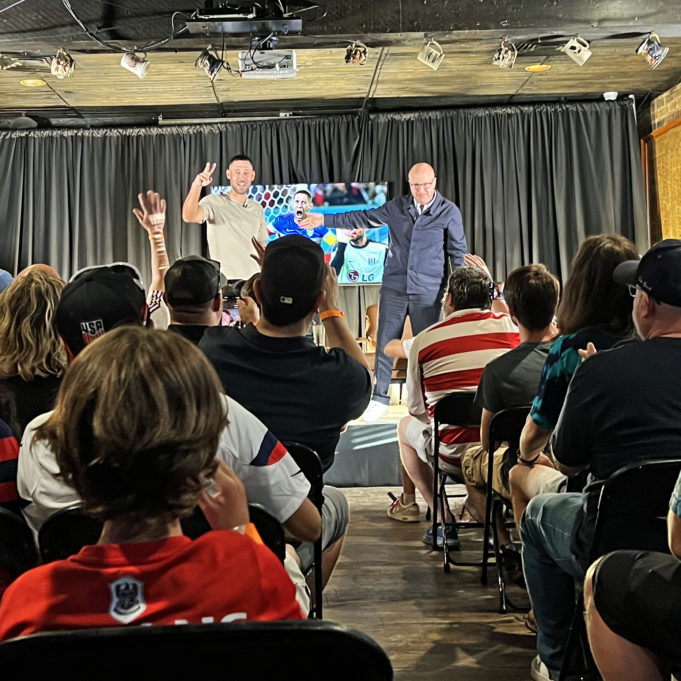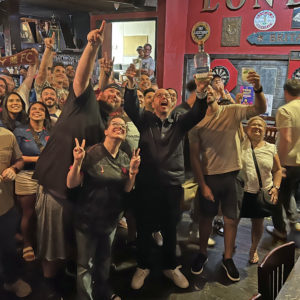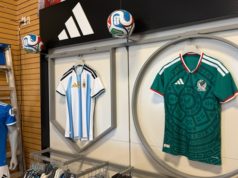Saturday night, a soccer podcast discussed how a number of the USMNT’s best players had come through the North Texas area in their development path. The discussion included names like Weston McKinnie, Ricardo Pepi, and Chris Richards, the goal scorer in Thursday’s 1-0 win against Saudi Arabia in the CONCACAF Gold Cup.
The session also focused on one of the best to ever compete for the men’s national team – a player who also happened to come through the region quite a bit during his youth: Clint Dempsey. In fact, Dempsey co-hosted the podcast. It’s a new venture with the Men in Blazers Media Network titled “The Deuce,” after his nickname.
“Clint was the most ferocious, the most tenacious, the most competitive warrior this nation has produced on the men’s side,” explained MIB Founder and CEO Roger Bennett of the decision to work with Dempsey. “To have someone join our network who is an authentic gentleman, who’s lived it, given it all, suffered for, won it, seen it all come and be the voice of the United States football team as we approach a World Cup on home turf, that’s simply what our dream was.”
Bennett co-hosted Saturday’s live podcast from the Londoner pub in Addison. The Liverpool native remembered to call it “Addison,” too, differentiating himself from a host of non-native pundits who tend to refer to events in any of the region’s municipalities as taking place in “Dallas.” In fact, he took joy in audience questioners who identified themselves as hailing from Coppell and Farmer’s Branch.
“I love it. There’s a real closeness and a real pride and a real sense of geography and place that is really remarkable,” he said of Texans as we discussed my being from Fort Worth. He also seemed taken by Dempsey’s hometown of Nacogdoches and wants to join him for some outdoor sports there.
Bennett directed some of the early on-stage discussion to the way his new colleague’s parents used to make a six-hour round trip so the promising young athlete could play for the Dallas Texans club team and in competitions like the Dallas Cup.
“For us growing up, that was a chance to play at the highest level possible. And if you wanted to try to go to college, you needed to be on a good club team to play in college showcases,” explained Dempsey during the podcast. “It made me appreciate at a young age, like, anything less than my best would be a slap in their face. So I really appreciate my parents, just the sacrifices that they made for me.”
Dempsey did play at the NCAA level at Furman before moving on to play for Major League Soccer teams and eventually English clubs. He also became a force for his national team, helping it to some of its greatest successes. Building on such triumphs has proven challenging for Dempsey’s successors in the squad. Though the USMNT has advanced to this year’s Gold Cup knockout round, their play has left room for criticism.
“The game itself is a pretty tough watch. It really was. We had 72% possession in the first half. We had zero shots on goal,” said Bennett on stage of the game against Saudi Arabia. “The quality of the football has been very flat.”
Dempsey wants the current group, including the large number of young players, to take a page from his approach to the game.
“You need to have a certain type of mentality when you do have moments in the game that you can drive forward with the ball. And I just remember when I was coming up and I was kind of a new face in the team. It was if I got a chance to drive with the ball, you better believe I’m driving with it to try to make something happen,” he said to the live audience of 50+ soccer fans and others watching the live stream. “People need to go out there and not have that fear. And I think sometimes, if you’re a young player that’s out there, you can’t let the risk of making a mistake keep you from going out there and expressing yourself. So I would like to see them do more of that.”
Concern has persisted for some years that the United States developmental system lags behind other regions in fostering creative players at the highest levels. Working on the documentary series Raising Her Game (now streaming free on Victory+), I heard that concern from people involved in the women’s game. The series also traced the evolution of the sport in the U.S., including the seminal moment when the country hosted its first World Cup in 1994. That was the year Bennett moved across the pond.
“’94 was the first time I’d seen American players play en masse,” he said of the World Cup squad that made the round of 16. “They owned it and they didn’t belong, but they didn’t for a second believe that they didn’t belong, and so they enforced their will in these games. And the second I saw them, I adored them.”
In those days, few Americans had any professional soccer opportunities, with Major League Soccer still two years off and berths in overseas clubs hard to come by. Even in the Dempsey era that emerged in the 2000s, few U.S. players could earn regular Premier League minutes like he did. Ironically, the country’s representatives now have a far more significant presence in the world’s top leagues. But it hasn’t quite propelled the national team into the world’s elite.
“I still believe this nation, with the greatest crop of footballers we’ve ever produced on the men’s side, can do remarkable things. And the question is whether we can self-organize to make that dream become a reality,” Bennett told me. He thinks more than just the starting eleven need to explore European football.
“American coaching is still the greatest backwater in this nation,” he suggested. “We have very few coaches that are willing to follow the way of becoming a great coach, which is to be an assistant, serve an apprenticeship, learn and grow. We’re still a kind of a monoculture where you become an MLS coach. And ultimately, unless we can crosspollinate, great coaches come by crossing borders, by crossing ideas, by developing new ideas in new places. (Former U.S. National Team Head Coach) Bob Bradley was a coach that challenged himself. He went to Egypt, he went to Scandinavia, he went to France. But you can count the number of American coaches that have done that on one set of hands.”
Bradley also coached in the U.S. college game from whence Dempsey emerged. Almost the entirety of the 1994 U.S. World Cup team had played at the university level. Less than a third of the 2022 team had college experience, with many coming through professional teams’ academy systems. Another topic we looked at in Raising Her Game had to do with whether NCAA competition can still play a role in professional and national team player development. That role has clearly diminished for the men’s side and may be doing so for the women’s as well.
“In the Premier League, the best footballers are breaking through when they’re 17, 18. I mean, that’s how the world is sculpted. These footballers at youth development academies are targeted,” Bennett pointed out. “The women’s game, we’re starting to see the same route.” He cited Olivia Moultrie, who turned pro at 13, as an example of a superb player who felt she needed a more soccer-intensive environment than college would have provided her. We won’t know for perhaps decades if any one individual made the right choice for themselves to bypass higher education, but professionalization may offer some advantages in terms of creating the best national teams.
“Football is like a game that’s prime between the ages of 17 and probably 26, 27,” Bennett noted.
He also suggested that American college sports is “becoming more and more like the football game” thanks to recent court settlements and NIL developments. So who knows – perhaps that pendulum will swing back.
What Bennett and Dempsey both fervently want is for the game of soccer to grow in the United States.
“That’s all you want, is to grow the game and leave it better than when you found it, and hopefully that’s what we did,” Dempsey said of his own contributions on the pitch.
Hosting another World Cup in the country next year will no doubt add some glow to the game the same way 1994’s did. Certainly, if the U.S. team could make a strong run, it would help. To that end, finding the proper development system, coaching, and other inputs to fuel elite performance matters. But one of the big differences between now and 1994 is that the USMNT isn’t on its own any more. It now has help.
In the room Saturday, one could observe an impressive variety of kit among the spectators. Of course, we saw several U.S. shirts, some with Dempsey’s name on the back. But we also saw allegiances to multiple club teams on display. Dempsey’s Fulham jersey appeared next to those of big clubs like Arsenal, Bayern Munich, and a Manchester United Hawaiian shirt (really). Bennett no doubt loved it that a person wore a jersey for his favored Everton club. And we saw the locals, too – FC Dallas and Dallas Trinity FC.
All those attendees had an interest in the USMNT analysis Bennett and Dempsey imparted. But they also clearly have a lot more soccer on their minds than just the guys wearing the stars and stripes. And so even as all U.S. supporters desperately hope for the day its national team can make a breakthrough on the world’s biggest stage, it reminds us that that’s not the only measure of success.
“This room, this energy, this joy, this passion, this hope, it’s what’s inspiring,” Bennett said of the assembly in the room and those watching his podcast live online. He’s right.












